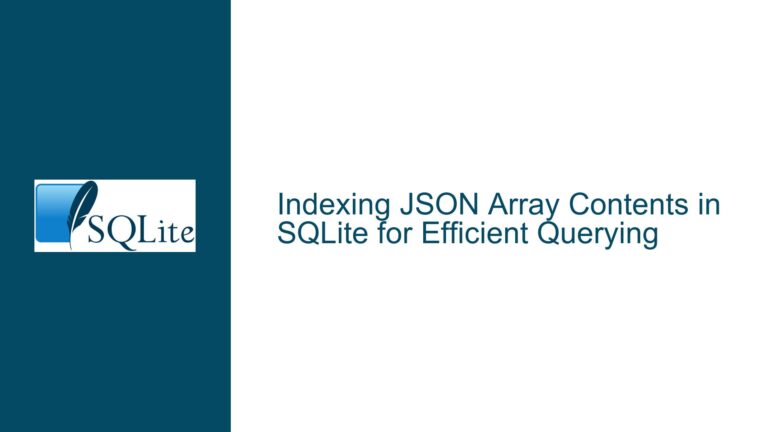SQLite Query Planner Not Using Expected Index: Troubleshooting and Solutions
Understanding Why SQLite Query Planner Chooses ix_treatments_checkInYear Over ix_treatments_treatmentTitle
The core issue revolves around the SQLite query planner’s decision-making process when selecting indexes for query execution. In the provided scenario, the query planner consistently chooses the ix_treatments_checkInYear index instead of the expected ix_treatments_treatmentTitle index, despite the query’s filtering condition involving treatmentTitle. This behavior can be attributed to several factors, including the structure of the indexes, the query’s filtering and grouping requirements, and the statistical data available to the query planner.
The ix_treatments_checkInYear index is defined on the deleted and checkInYear columns, while the ix_treatments_treatmentTitle index is defined on the deleted and treatmentTitle columns. The query planner’s decision to use ix_treatments_checkInYear suggests that it considers this index more efficient for the given query, likely due to the grouping requirement on checkInYear and the filtering condition on deleted. The query planner may estimate that using ix_treatments_checkInYear reduces the number of rows to process during the grouping phase, even though the treatmentTitle filter is applied later.
Additionally, the query planner relies on statistical data collected by the ANALYZE command to make informed decisions about index usage. If the statistical data indicates that the ix_treatments_checkInYear index is more selective or efficient for the query’s conditions, the query planner will prioritize it over other indexes. This behavior can be further influenced by the presence of virtual columns, such as checkInYear, which are computed at runtime and may affect the query planner’s cost estimations.
Exploring the Impact of Index Structure, Query Conditions, and Statistical Data on Index Selection
The structure of the indexes plays a critical role in the query planner’s decision-making process. In this case, the ix_treatments_checkInYear index includes the deleted column as the first column, followed by checkInYear. This structure aligns with the query’s filtering condition on deleted and the grouping requirement on checkInYear, making it a seemingly optimal choice for the query planner. On the other hand, the ix_treatments_treatmentTitle index includes the deleted column followed by treatmentTitle, which aligns with the filtering condition on treatmentTitle but does not directly support the grouping requirement on checkInYear.
The query conditions also influence the query planner’s index selection. The query includes a LIKE condition on treatmentTitle, which can be less selective compared to equality conditions. The query planner may estimate that using the ix_treatments_checkInYear index and applying the treatmentTitle filter later is more efficient than using the ix_treatments_treatmentTitle index and performing additional computations for checkInYear.
Statistical data collected by the ANALYZE command provides the query planner with information about the distribution of values in the indexed columns. If the statistical data indicates that the ix_treatments_checkInYear index is more selective or efficient for the query’s conditions, the query planner will prioritize it over other indexes. However, if the statistical data is outdated or incomplete, the query planner may make suboptimal decisions. Running ANALYZE with representative data can help ensure that the query planner has accurate statistical information to make informed decisions.
Step-by-Step Troubleshooting and Solutions for Optimizing Index Usage in SQLite Queries
To address the issue of the query planner not using the expected index, follow these troubleshooting steps and solutions:
Verify Index Definitions and Query Conditions: Ensure that the indexes are defined correctly and align with the query’s filtering and grouping requirements. In this case, the
ix_treatments_treatmentTitleindex should be defined withtreatmentTitleas the first column to optimize its usage for queries filtering ontreatmentTitle.Run
ANALYZEwith Representative Data: Execute theANALYZEcommand to collect statistical data on the indexed columns. This data helps the query planner make informed decisions about index usage. Ensure that the database contains representative data that reflects the actual distribution of values in the indexed columns.Use the
INDEXED BYClause: If the query planner consistently chooses a suboptimal index, use theINDEXED BYclause to explicitly specify the desired index. For example:SELECT checkInYear, Count(DISTINCT materialsCitations.materialsCitationId) AS num FROM treatments INDEXED BY ix_treatments_treatmentTitle JOIN materialsCitations ON materialsCitations.treatmentId = treatments.treatmentId WHERE treatments.deleted = 0 AND treatments.treatmentTitle LIKE 'Crematogaster%' AND materialsCitations.deleted = 0 GROUP BY 1;This forces the query planner to use the specified index, provided a valid query plan exists.
Optimize Index Structure: Consider restructuring the indexes to better align with the query’s requirements. For example, create separate indexes for active and deleted records:
CREATE INDEX ix_treatments_treatmentTitle_active ON treatments (treatmentTitle COLLATE NOCASE) WHERE deleted = 0; CREATE INDEX ix_treatments_treatmentTitle_deleted ON treatments (treatmentTitle COLLATE NOCASE) WHERE deleted = 1;These indexes can improve query performance by reducing the number of rows to scan.
Evaluate Query Performance: Test the query with different indexes and analyze the query plans to determine the most efficient approach. Use the
EXPLAIN QUERY PLANstatement to compare the performance of different query plans and identify potential bottlenecks.Consider Virtual Columns and Computations: If the query involves virtual columns or computed values, such as
checkInYear, evaluate their impact on query performance. Consider storing computed values in a physical column if they are frequently used in queries.Monitor Query Planner Behavior: Continuously monitor the query planner’s behavior and adjust the indexes and query conditions as needed. Keep the statistical data up to date by running
ANALYZEperiodically, especially after significant changes to the data.
By following these steps, you can optimize index usage in SQLite queries and ensure that the query planner selects the most efficient indexes for your specific requirements. This approach not only improves query performance but also provides greater control over the query execution process, allowing you to achieve consistent and reliable results.






